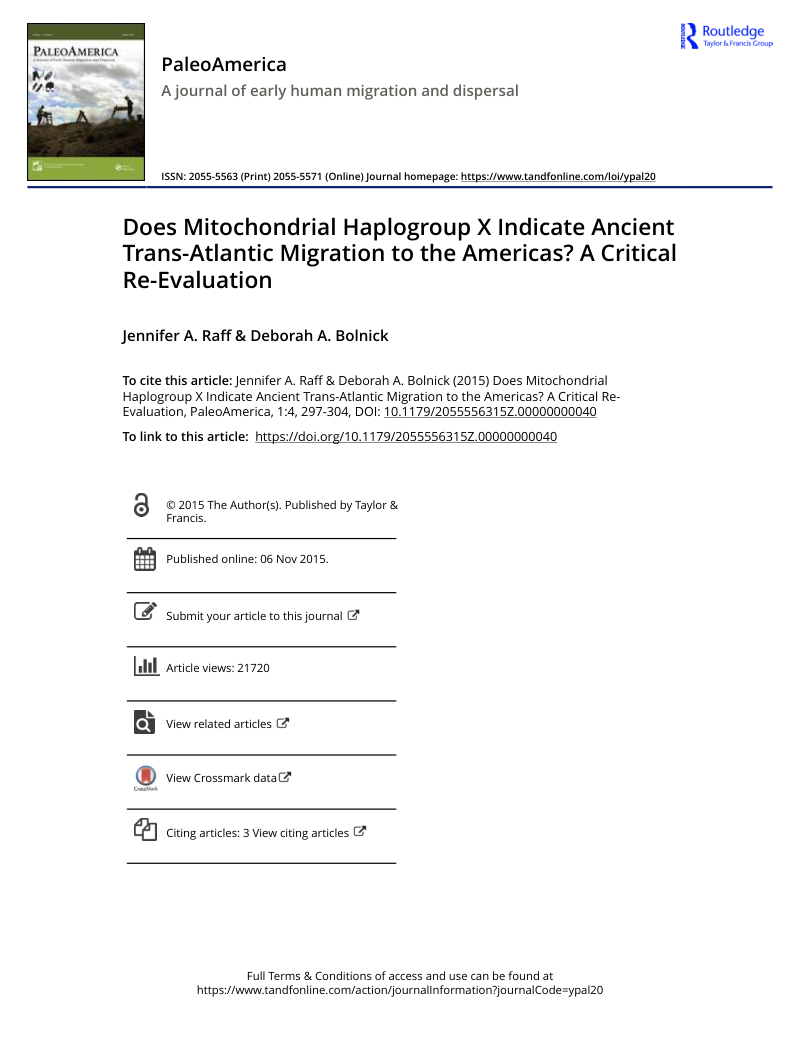Jennifer A. Raff and Deborah A. Bolnick review the evidence for haplogroup X2a; conclude it does not lend support to theory of migration from Near East to America.
- Type
- Academic / Technical Report
- Source
- Jennifer Raff Non-LDS
- Hearsay
- DirectSecondary
- Reference
Jennifer A. Raff and Deborah A. Bolnick, “Does Mitochondrial Haplogroup X Indicate Ancient Trans-Atlantic Migration to the Americas? A Critical Re-Evaluation,” PaleoAmerica: A Journal of Early Human Migration and Dispersal 1, no. 4 (2015): 297–304
- Scribe/Publisher
- PaleoAmerica
- People
- Deborah A. Bolnick, Jennifer Raff
- Audience
- Reading Public
- Transcription
It might seem strange for an article to focus largely on the history of a single mitochondrial haplogroup in an era when complete genome sequencing is becoming more common. But as recent publications and film documentaries have shown (Meldrum Citation 2009; Oppenheimer et al. Citation 2014; Smoot et al. Citation 2010; Stanford and Bradley Citation 2012), there is still considerable confusion about what the structure of mitochondrial genetic diversity in the Americas means for Native American population history. Specifically, there are persistent claims that the presence of mitochondrial haplogroup X2a in Native American populations is evidence for ancient trans-Atlantic gene flow from Europe or the Middle East into North America (Meldrum Citation 2009; Oppenheimer et al. Citation 2014; Smoot et al. Citation 2010; Stanford and Bradley Citation 2012). If true, this genetic evidence would lend considerable support to the Solutrean hypothesis, which suggests that the North American Clovis culture (13,300–12,800 cal yr BP) is directly descended from the Solutrean culture of southwestern Europe (23,500–18,000 cal yr BP). The current iteration of the Solutrean hypothesis was developed by Bruce Bradley and Dennis Stanford (Bradley and Stanford Citation 2004; Stanford and Bradley Citation 2012; see Abbott Citation 1877, Greenman Citation 1963 and Hibben Citation 1941 for previous iterations of the hypothesis), and it has been heavily critiqued by many archaeologists (Eren et al. Citation 2013, Citation 2015; O'Brien et al. Citation 2014; Philips Citation 2014; Sellet Citation 1998; Straus et al. Citation 2005).
The idea that haplogroup X2a is derived from an ancient trans-Atlantic migration to the Americas has been repeatedly considered — and rejected — by anthropological geneticists over the last two decades (Brown et al. Citation 1998; Fagundes et al. Citation 2008; Reidla et al. Citation 2003; Smith et al. Citation 1999, 2005). However, we revisit it here because it continues to be discussed and because recently published genomic data from ancient and contemporary North Americans help clarify the population history of North America and the likely history of this haplogroup.
- Citations in Mormonr Qnas
The B. H. Roberts Foundation is not owned by, operated by, or affiliated with the Church of Jesus Christ of Latter-day Saints.

